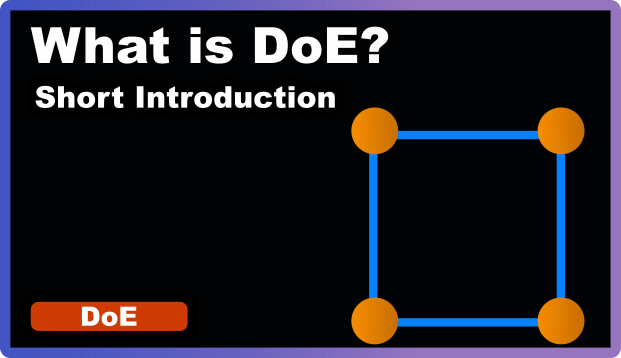
What is Design of Experiments? (DoE Basics)
Does this sound familiar?
You’re in the lab, trying to improve a formulation. You change one factor… not the expected outcome… change another factor… again, not the expected outcome… change another factor… Oh! Looks promising… But when you run the experiment again… False alarm.
You go again and again deeper and deeper into the rabbit hole until you don’t even know what you already tested and what not. Well, that is exactly what DoE was invented for to stop.
What is DoE?
Short answer: Design of Experiments (DoE) is a structured way to plan, run, and analyze experiments so you get maximum information from the fewest possible trials.
Long answer: Well, let’s just skip that one. Nobody wants to read much anyway. But let me just say: It’s pretty simple. In the beginning, you make a list of all the different factors that you think influence the variable you want to test. From that list, you select which ones you want to vary in your experiment and which one you want to keep constant (we get to what to do if you can’t keep them constant in this post: Principles of DoE: Randomization, Replication, Blocking). Last but not least, you plug everything into your favorite software tool, select the right design (no worries, we talk about that as well), and execute the design the software provides. In the end, you use the same software for the analysis.
However, there is a little bit more to it because if it was that simple, you wouldn’t have to read this post. In a nutshell, the description above is correct, and you could say that a DoE is just one carefully planned experiment. But in practice, I would say that a good DoE consists of more than one experiment.
The Four-Step Approach to Successful DoE
Why can’t you just do one experiment? Simple. Because you probably don’t know enough to plan one good experiment. Most likely, you are missing information on which factors are important. Maybe the catalyst you chose isn’t effective. Then you don’t want to spend a lot of resources testing each and every concentration. Or the temperature range you picked doesn’t include the sweet spot. That’s why it helps to think of DoE not as a single shot, but as a process—a series of connected experiments where each step teaches you something new.
Step 1: Explore the Boundaries
I work in chemistry and the first thing I usually do is head to the lab and just play around a bit with the ingredients. At this point, I’m mostly testing boundaries.
- Which chemicals even work?
- Which concentrations make sense?
- When does the product fall apart?
- How much catalyst do I need to make it cure?
- How much solvent do I need to add before it becomes a workable mixture?
It’s not fancy, but it gives me a ballpark. Once I’ve mapped out that rough territory, then I’m ready to set up a proper screening design.
Step 2: Screening - What matters?
There are a number of screening designs to choose from and we’ll get to that. In general, screening designs allow you to test many factors with relatively few experimental runs. So that is what you should do. Test as many factors as possible within the identified boundaries. You’re not looking for perfection here. You’re looking for clues. Something that stands out, something that says: “Hey, look at me!”. Because often it’s not many factors that drive a system. It is only a few and those are the ones we try to find with a screening design.
Step 3: Refinement
Once you identified the key players, it’s time to zoom in. Ideally, you reduced the number of factors from somewhere around ten to four or five. Maybe you can also narrow down the factor ranges or shift them a little. Now you would also switch from a screening design to a full factorial design, as with full factorial designs, you are able to find interactions between factors that you didn’t expect. For example, that the catalyst only works with a certain type of curing agent or is more effective at lower temperatures. Those interactions usually get lost in screening designs.
Step 4: Optimization
By now, you’ll probably have a feeling for the sweet spot and you are pretty certain about the factor ranges that get you maximum performance, minimum cost, or whatever your goal is. That would be the last step of this DoE process. Maybe you don’t need it if your goal wasn’t to find the maximum performance but just to reach a certain level. That is also great. No hard feelings then.
Final Words
Each step does not need a whole new set of experiments. You can reuse the data from earlier steps and build on what you’ve already done, so the overall effort stays pretty manageable.
In the next chapters, we’ll break things down further: the different types of design plans, how to detect and visualize interactions between factors, and how to make sure your data is solid.
But before we dive deeper, let’s learn the core language of DoE—factors, levels, responses.